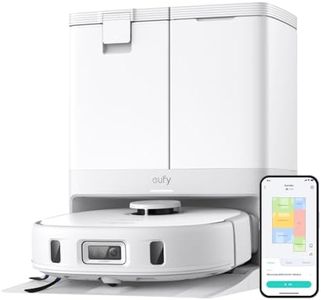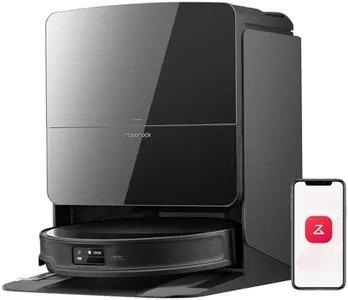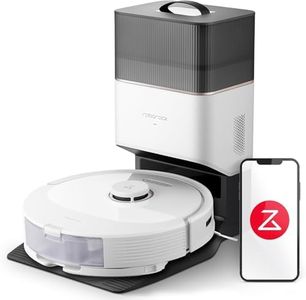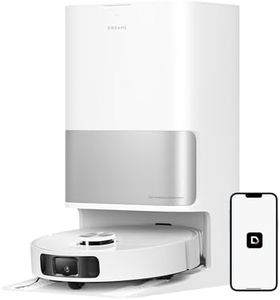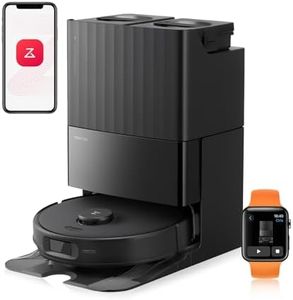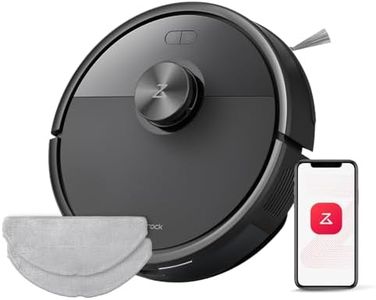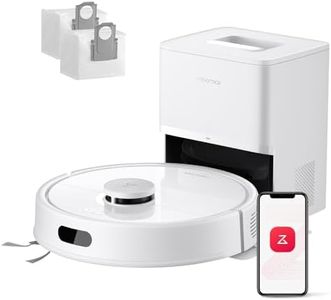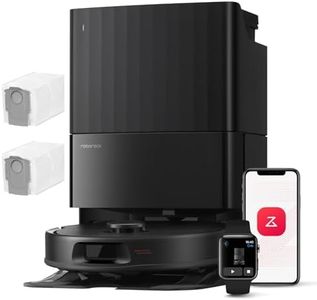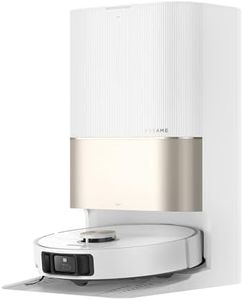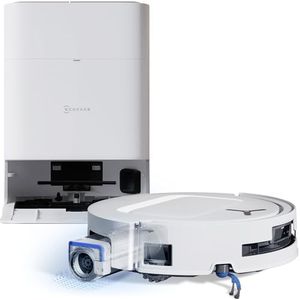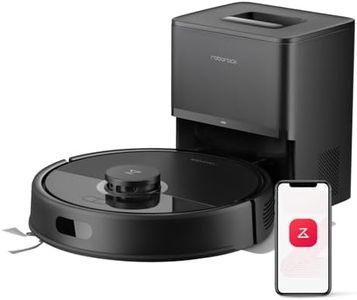10 Beste Saugroboter
Von führenden Marken und Bestsellern, die im Internet erhältlich sind.Unsere Top-Auswahl
Gewinner
roborock Saros 10R Saugroboter mit Wischfunktion&angebbarem Wischmopp, 7,98cm Ultra-Slim Design, StarSight System 2.0, Zero-Tangle System
Der Roborock Saros 10R ist ein moderner Saugroboter mit sehr starker Saugleistung von 22.000 Pa, was bedeutet, dass er auch tiefsitzenden Schmutz und Tierhaare zuverlässig entfernt. Sein ultraflaches Design mit nur 7,98 cm Höhe ermöglicht die Reinigung unter Möbeln wie Sofas und Betten, wo andere Geräte oft nicht hinkommen. Das fortschrittliche StarSight System 2.0 sorgt für eine präzise Navigation, indem es Hindernisse und auch herumliegende Kabel erkennt und elegant umgeht, was die Reinigung effektiver macht. Dank des Zero-Tangle-Systems verheddern sich lange Haare nicht in den Bürsten, was die Wartung sehr einfach gestaltet. Die Kombination aus Seitenbürste und ansteckbarem Wischmopp mit FlexiArm-Technik sorgt dafür, dass auch Ecken und Kanten gründlich gereinigt werden.
Besonders praktisch ist das abnehmbare Gehäuse und die unabhängige Radverstellung, die eine sehr gute Bodenabdeckung ermöglicht, selbst auf unebenen Flächen. Die Multifunktions-Dockingstation übernimmt Wartungsaufgaben automatisch, wie das Entfernen der Mopps vor Teppichreinigung, was die Handhabung erleichtert. Der Roboter ist per App und Sprachsteuerung via Amazon Echo oder Google Home kompatibel und benötigt ein 2,4-GHz-WLAN. Die starke Leistung und smarten Funktionen lassen auf eine solide Nutzungsdauer schließen. Auch bei der Betriebslautstärke ist von einem moderaten Geräuschpegel auszugehen, der für viele Haushalte passend ist.
Dieser Saugroboter eignet sich besonders für Haushalte mit vielen Möbelstücken und Tierhaaren, die eine gründliche und smarte Reinigungslösung suchen. Nutzer, die Wert auf einfache Wartung und flexible Navigation legen, finden im Saros 10R eine sehr gute Wahl.
roborock Qrevo Curv S5X-Set Saugroboter mit Wischfunktion Absaugstation, Dual Anti-Tangle-System, 18.500 Pa Saugkraft, 75°C Heißwasser-Moppwäsche, Intelligente Schmutzerkennung, All-in-One-Dock (Weiß)
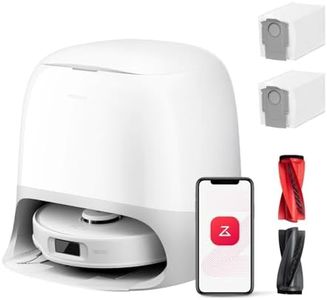 roborock
roborockDer roborock Qrevo Curv S5X ist ein leistungsstarker Saugroboter, der mit einer sehr hohen Saugleistung von 18.500 Pa auch tief sitzenden Schmutz aus Teppichen und Ecken gut entfernt. Dank des innovativen Dual Anti-Tangle-Systems verheddern sich Bürsten kaum, was besonders für Haushalte mit langen Haaren oder Haustieren praktisch ist. Die Navigation funktioniert präzise per Laser, wodurch Räume genau erfasst und gezielt gereinigt werden. Mit einer Betriebszeit von etwa 3 Stunden ist der Akku für größere Wohnungen gut geeignet.
Die Steuerung erfolgt bequem per App, die über WLAN verbunden wird, und ermöglicht individuelle Reinigungspläne sowie die Festlegung von No-Go-Zonen. Der Staubbehälter ist mit 220 ml eher klein, sodass häufiger geleert werden muss. Positiv fällt die Wischfunktion mit 75 °C heißem Wasser auf, die für eine hygienische und gründlichere Reinigung sorgt, unterstützt von einer intelligenten Schmutzerkennung, die bei Bedarf den Wischvorgang wiederholt. Mit etwa 62 Dezibel arbeitet der Roboter relativ leise, stört also kaum im Alltag.
Der Qrevo Curv S5X ist besonders geeignet für Nutzer, die Wert auf starke Saugleistung, smarte Navigation und eine effektive Wischfunktion legen. Wer jedoch einen größeren Staubbehälter bevorzugt oder auf eine längere Akkulaufzeit angewiesen ist, sollte dies beachten.
ECOVACS DEEBOT T50 PRO Omni Saugroboter mit Wischfunktion, Ausfahrende Seitenbürste und Wischmopp, 15.000 Pa, T30 PRO OMNI-Upgrade, Auto Zugabe von Reinigungslösung, Moppwäsche mit 75°C heißem Wasser
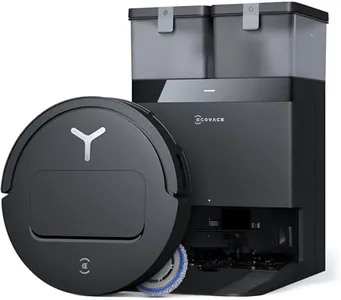 ECOVACS
ECOVACSDer ECOVACS DEEBOT T50 PRO Omni ist ein leistungsstarker Saugroboter mit einer Saugleistung von 15.000 Pa, was ihn effektiv für die Reinigung von Staub und Schmutz macht. Besonders praktisch ist die integrierte Wischfunktion mit automatischer Zugabe von Reinigungslösung und heißem Wasser bis 75°C, die für eine gründliche Bodenpflege sorgt. Die ausfahrbare Seitenbürste und selbstreinigende Bürstenwalze unterstützen eine gründliche Kanten- und Eckreinigung.
Mit dem LiDAR dToF-Modul besitzt der Roboter eine präzise Navigationstechnologie, die es ihm ermöglicht, Räume gut zu erfassen und systematisch zu reinigen. Die Steuerung erfolgt unter anderem über den YIKO Voice Assistant, was die Bedienung für Nutzer bequem macht. Die mitgelieferte OMNI-Station erleichtert die Reinigung und Wartung des Roboters, trägt aber auch zum relativ hohen Gewicht von 15 Kilogramm bei.
Die Ausstattung des T50 PRO Omni eignet sich besonders gut für Nutzer, die Wert auf eine Kombination aus Saugen und Wischen legen und eine intelligente Navigation wünschen. Für sehr große Flächen oder spezielle Bodenbeläge empfiehlt sich vor dem Kauf ein genauerer Blick auf die Akkulaufzeit und die Bodenverträglichkeit.
Top-Auswahl vergleichen
roborock Saros 10R Saugroboter mit Wischfunktion&angebbarem Wischmopp, 7,98cm Ultra-Slim Design, StarSight System 2.0, Zero-Tangle System Auf Amazon ansehen | roborock Qrevo Curv S5X-Set Saugroboter mit Wischfunktion Absaugstation, Dual Anti-Tangle-System, 18.500 Pa Saugkraft, 75°C Heißwasser-Moppwäsche, Intelligente Schmutzerkennung, All-in-One-Dock (Weiß) Auf Amazon ansehen | ECOVACS DEEBOT T50 PRO Omni Saugroboter mit Wischfunktion, Ausfahrende Seitenbürste und Wischmopp, 15.000 Pa, T30 PRO OMNI-Upgrade, Auto Zugabe von Reinigungslösung, Moppwäsche mit 75°C heißem Wasser Auf Amazon ansehen |
|---|---|---|
| Angebot | ||
17%billiger | - | - |
| Ausgewählt von | ||
| 1.177 | 1.075 | 973 |
| Mehrere Stile verfügbar | ||
| Suction Power | ||
| 22.000 Pa | 18.500 Pa | 15.000 Pa |
| Navigation Technology | ||
| StarSight System 2.0, präzise Laserkartierung | Präzise Laserkartierung und Navigation | LiDAR dToF-Modul |
| Connectivity and Control | ||
| App, Sprachsteuerung, Amazon Echo, Google Home | Amazon Echo, Google Home, App-Steuerung | YIKO Voice Assistant |
| Floor Type Compatibility | ||
| unebene Flächen, Möbelunterseiten, ultraflach 7,98 cm | -- | -- |
| Additional Features | ||
| Boost-Intellekt, Zero-Tangle, Seitenbürste, Wischmopp | Anti-Tangle, No-Go-Zone, Zimmerreinigung, Wischfunktion | Seitenbürste, Selbstreinigende Bürstenwalze, Wischfunktion, OMNI-Station |
| Battery Life | ||
| -- | 3 Stunden 10 Minuten | -- |
| Dustbin Capacity | ||
| -- | 220 Milliliter | -- |
| Noise Level | ||
| -- | 62 Dezibel | -- |
